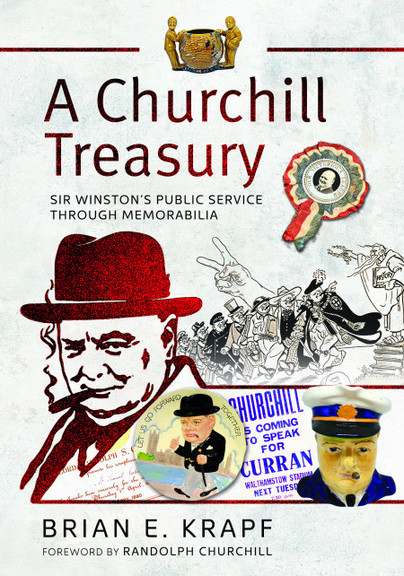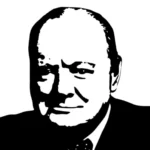Bulletin #193 — Jun 2024
Museum-grade History

To view in full, right click and choose "View in new tab"
May 31, 2024
Brian E. Krapf, A Churchill Treasury: Sir Winston’s Service through Memorabilia, Pen & Sword, 2024, 224 pages, £25 / $49.95. ISBN 978–1399017015
Review by ALASTAIR STEWART
Last month, my wife and I moved home. It was a joyful, happy occasion marred only by my shocked realisation that a beloved bust of Winston Churchill had gone walkies. I began to obsess; it had sat on my desk for years. Chip-in-his-honorary-air commodore’s-cap-and-all, the bust was more than memorabilia; it held great emotional significance.
That experience was oddly timed with the release of Brian Krapf’s book A Churchill Treasury: Sir Winston Churchill’s Public Service through Memorabilia. Krapf, a renowned name among the readers of Finest Hour, is the collection columnist for the Churchill Bulletin, specialising in all things “Churchilliana.” His thirty-year passion for finding and collecting Churchill memorabilia, oddities, and commemoratives from each facet of the great statesman’s public life is truly remarkable. The results are museum-grade history.
The question posed by this book is intriguing: can Churchill’s life honestly be told through memorabilia? If it was anyone else, the question might seem flimsy. How can a life be told through knick-knacks, however vast the assemblage is? Krapf’s collection is a catalogue of graft, achieved by enthusiastically searching through antique fairs, malls and shops, and British and American online auctions. When presented in book form, it offers a unique perspective full of historical cues many will not have seen before. Yes, there are some oddities, such as the Churchill maracas and hanging folk art. But there are invitations, pennants, posters, and flags that give a real insight into the politics of propaganda, commemoration, and morale boosting.
For those further stretching to find a new angle about the former Prime Minister, this book will come as nothing but a sharp shock of a treat. It is less a study of novel antiquities and more a visual handbook of how global communities saw historical figures. That is a spectrum that encompasses the banal to the bizarre. When one considers saccharine tokens made for royal occasions or gaudy election propaganda, their contribution is not in boosting a bustling tourist trade but in recording how people saw these figures and events at the time. For that reason alone, beyond some optimistic aesthetic value, they are historically paramount and deeply significant.
One item that resonates with me is Churchill’s 1940 life-story picture book made to help parents explain new wartime restrictions to their children. It is strangely familiar to those of us who had to explain the impositions and dangers caused by COVID-19, but it is astonishing to see such a dovetail to the past. That Churchill’s life was so exciting to merit a colourful children’s book is a subtle testament to why Krapf’s book is so interesting.
The unusual and the bespoke are often lost among the sea of toby jugs and poorly executed busts. Krapf focuses on the unique, and the book is a masterful telling of Churchill’s life through rarer items. Everyone will have a favourite, but general election literature, satirical magazines, and posters and flags for speaking engagements, like the famous “Iron Curtain” speech delivered in Fulton, Missouri, are genuinely compelling and help make these increasingly distant historical events more tangible. There is something eerily contemporary about the 1932 poster for Churchill’s speech at Carnegie Hall as part of the Pittsburgh lecture series. The BBC’s The Listener publication printing Churchill’s 1934 “Causes of War” speech could likewise have been made today when seen in full colour.
The book’s structure is much appreciated, for ordered logic provides ease of dipping in and dipping out, beginning with Lord Randolph Churchill and ending with items related to Sir Winston’s retirement after his second premiership. This linear presentation is no criticism, and the laurel of the “coffee table” book is not to be denigrating. In fact, these qualities demonstrate that even the most disinterested or unfamiliar soul can find entertainment and curiosity in turning these pages. Mass appeal for such a niche topic is testament to the author’s enthusiasm. After all, at the time of writing, I cannot tell you if Churchill has been the only prime minister turned into a jigsaw puzzle, brandishing a sword following his appointment.
Churchill lived for ninety years, and it is telling of Krapf’s research that there is so much left out, as he acknowledges. One can greedily imagine a sequel, and it will surely pique readers’ interest to wonder what did not quite make the cut in this book. Pen and Sword are known for publishing titles that focus on lesser-known aspects of history and subjects of nuanced and bespoke interest. This book does not belong in that category. It is a blockbuster and a must-have for any Churchill fan.
A Churchill Treasury is an absorbing, full-colour companion filled with the kind of litany of material that enriches serial telling and retellings of Churchill’s life. It has managed that minor miracle in Churchill scholarship of offering something fresh (“Winston Churchill soap bars” is not a line I ever expected to write.)
Profusely illustrated, the book includes photographs of badges, ribbons, textiles, porcelain, glassware, and ephemera. Each item, however, also is provided with superb context through detailed explanations of the object’s history, story, and rarity. These are delightful, easy reads that convey the author’s zeal and mastery of his subject—no small feat, given the scope and scale of the collectables within.
If I had to choose a favourite, it would be the 1959 election poster using only Churchill’s silhouette. It smacks of a superhero movie and is a superb bit of advertising. Krapf may have just proven that modern movie marketing owes something to Churchill’s political campaigning.
It must be said that Penn & Sword have produced a book of excellent physical quality, the likes of which we seldom see these days. Printed on glossy, heavy-stock paper, the genuinely sewn-in pages are handsomely bound in sturdy, red buckram. This book will hold up well to repeated use.
A month after settling into our new home, I found my dented Churchill bust in the bottom box inside our shed. Looking through Krapf’s collection inspires me and will inspire you as well to start or expand your own collection.
Alastair Stewart is Chair of ICS Scotland.
Subscribe
WANT MORE?
Get the Churchill Bulletin delivered to your inbox once a month.






